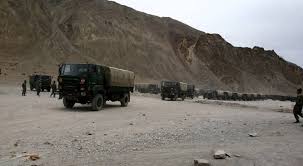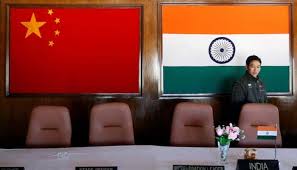India underrates China’s will to defend every inch of territory: Chinese analysts

Beijing: India’s latest military provocations on the China-India border are very different to that of the Doklam stand-off in 2017, as it dispatched more troops and displayed an extremely aggressive posture with Chinese experts saying that Indian decision-makers have seemingly underestimated China’s determination to protect its sovereignty.

Chinese analysts said New Delhi might believe that China is facing heavy pressure from the United States and focusing on handling tensions on its eastern side, such as in the Taiwan Straits and the South China Sea, so it assumes that it would be a good chance for India to push forward and force China to make a compromise.
If it succeeds, this would be a remarkable achievement for New Delhi to show off to its people and distract attention from the severe domestic COVID-19 epidemic and worsening economic situation, analysts told Global Times. India’s military activities have become increasingly aggressive in recent days, and border tensions see no sign of de-escalating.
According to Indian media reports, the Indian Army has changed its posture from border management to securing the border on the 1,597 km Line of Actual Control (LAC) in Ladakh, after the People’s Liberation Army (PLA) added a military deployment in the region.
India also deployed additional specialized forces such as the Special Frontier Force, and the Indian media said its soldiers have occupied, “key peaks on the southern bank of Pangong Lake.” Indian Army has paid special attention by deploying a combat group (a mix of armored and mechanized elements) on the Depsang Plains.

Indian Army Chief General Manoj Mukund Naravane has visited Leh, the largest town of Ladakh in India, to the west of Pangong Tso Lake, on Thursday amid the ongoing face-off. Indian media also reported in August that the Indian Army also gets ready for a long winter haul in Ladakh.
These high-profile activities showed that the Indian military and its government leaders were extremely sure of themselves, and even more sure than in the Doklam stand-off in 2017, and China must prepare for long-term tensions on the border, but if Indian troops invade Chinese territory and attack Chinese troops, no matter what kind of pressure China is facing to the east, India would surely pay a heavy price, said Chinese analysts.
Lin Minwang, deputy director at the Center for South Asian Studies at Fudan University, told the Global Times that India still wanted to negotiate rather than start a war, and its aggressive military activities are serving their purpose of keeping the border situation tense and forcing China to compromise, but it seems like they do not understand why China would not accept India’s claims.
China and India have different claims along the LAC, and the recent provocations prove that India wanted to gain more unrealistic concessions from China, Lin said, noting that through a series of negotiations after the conflict on June 15 causing casualties on both sides, Chinese and Indian soldiers have disengaged in some regions such as the Galwan River valley, but India still wanted Chinese troops to retreat from more regions like Pangong Tso Lake and Reqin Mountain to accept the “LAC” drawn by the Indian side.
“This is totally unfair and overcharged,” and if China accepts these claims and pulls back its troops from its own territory under military pressure from India, Indian troops would keep pressing forward and its provocations and aggressive posture would be endless, so that’s why China was furious this time and refuses to make any compromises, said Lin.
As the situation of India’s internal coronavirus epidemic takes a turn for the worse, and its economy is experiencing an unprecedented recession, India is expecting its aggressive behavior to draw support from the US, since it’s actively engaging in the US-proposed Indo-Pacific strategy, but this could prove to be a huge mistake with Chinese retaliation possible, Chinese analysts warned.
Before the latest tensions on the border, India has launched a series of unfair and nationalist sanctions against Chinese firms and banned apps in India, and China didn’t retaliate, so this could make Indian leaders believe that China will not retaliate either if they create more provocations on the border, said Lin.
Chinese experts said the border issue is about sovereignty which is totally different from the economy and trade, and on economic issues, China’s can regard India’s nationalist measures as unnecessary and pointless due to the Indian economy being too weak to be retaliated against by China, but regarding sovereignty, China will never compromise and India’s miscalculations will endanger its frontline troops.
Song Zhongping, a Chinese military expert and TV commentator, told the Global Times that the reason why PLA troops are being restrained was that China still hoped tensions could be de-escalated and it did not wish to create a new conflict that would harm overall relations between the two sides, rather than being purely afraid of Indian aggression.
“Chinese military forces, whether the army or air force, in the region are well-trained and their weapons have technological advantages over India’s. They are fully capable of cracking down against any Indian provocation at anytime if Indian troops invade,” Song noted.
China normally plans for the long-term when making decisions and any provocation from other countries “will be put on record in an account book,” just like the conflict of 1962, and back then, India had started its aggressive behavior from 1959.
But once the international situation was suitable for China to strike back, the PLA would take action and destroy Indian troops before New Delhi realized what had happened, said a Chinese military expert who requested anonymity.
In a recent survey made by the Global Times and the China Institutes of Contemporary International Relations, 89.1 percent of participants support military retaliation if India again launched a border conflict, and 50.4 percent of them “strongly support” self-defense and counter-attacks by force, while 38.7 percent of them only “relatively support” it.





